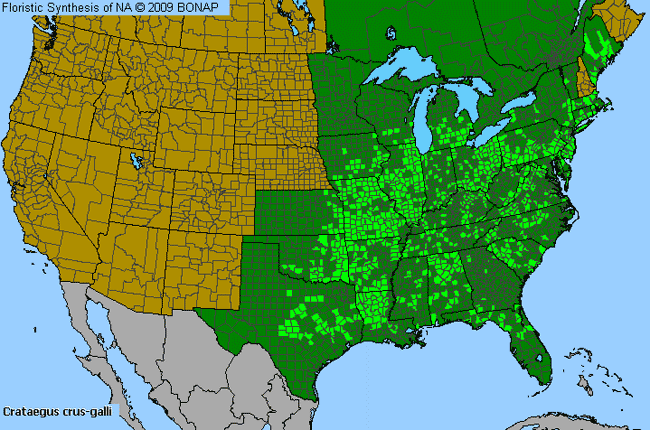Cockspur Hawthorn
Crataegus crus-galli L.
Description
Cockspur hawthorn is a member of the rose family (Rosaceae) ¹. This tree can grow between 20 feet to 30 feet tall and 20 feet to 25 feet wide, with 9-inch diameter trunk ². The bark of the tree is rough and shaggy with a gray and brownish color. As stated within its name, this tree has thorns, 2-3-inches long, which grow upon its horizontally grown branches and sometimes on the trunk of the tree ³. Giving a flat top shape to the canopy, the tree has simple leaves that are 1-3 inches long with serrate leaf margins that have alternative leaf arrangements ¹. The leaves are dark green in color with a smooth and glossy look. In the fall season the leaves turn red or orange 4. This is a deciduous tree, so the leaves do fall off in the winter. The tree also produces white flowers in the spring that form in clusters, and produce red, round fruits called the “haw” or “pome”, in the fall ².

First-year thorns of cocksure hawthorn. NCState Extension ²
Cockspur hawthorn flowers @ R.W Smith, 2012, Wildflower 8
Leaves and young fruits of cockspur hawthorn. @ J. Robbions, NC State Extension ²
Distribution
Cockspur hawthorn trees are distributed in North America along the Eastern United States, Ontario and Quebec, Canada, and west to Kanas, Oklahoma, and Texas ³. With its wide canopy, the tree can be grown in areas with full exposure sunlight, and grows in moist, but well-drained soils ¹. The tree can also tolerate growing in areas with partial sun exposure, but full exposure is preferable ². Cockspur hawthorn looks to be more abundant in some states than and less abundant in others. In Maryland, the cockspur hawthorn trees tend to grow within mountainous areas and along coastal areas of the state 5,6.

Distribution of cokspur hawthorn. Pollen Library 8
Wildlife importance
Cockspur hawthorn trees provide protection, habitat, or nesting, and can provide a good food source for birds, more specifically smaller birds like songbirds ². With the flowers produced, they can attract pollinators. The tree can also attract bees, butterflies, and moths. It serves a host for caterpillars of Gray Hairstreak, Red-spotted Purple and Viceroy butterflies ²,
Economic Importance
The tree is a garden or landscape tree and can be planted in areas for ornamental use 4. The pome on the tree can be edible. The fruit can be harvested and can either be eaten raw or cooked and can be used to make jelly ³. The tree can also have medical use, which can be used as a heart tonic to help with cardiovascular health such as high blood pressure 2,9. The wood of the tree can be used as wood for fence post due to its rot resistance 10.
Threats
The cockspur hawthorn tree has a high susceptibility to diseases and some pests. Diseases such as Fire blight, different types of rusts, powdery mildew, leaf pores, and many more can infect this tree 1,2,7. Pests include leaf miners and aphids 7 result in damage affecting leaves and even fruits. Aside from diseases and pests, these trees are tolerant against other environmental factors, such as fires and urban pollution 2,4.
Interesting facts
- The thorns on cockspur hawthorn tree are very sharp to the point that it can cause injury, its best to be cautious when children are within the vicinity 7.
- The flowers, when fully bloomed, emit an unpleasant aroma 7.
Reference
- The Morton Arboretum: Cockspur hawthorn
- North Carolina State Extension: Crataegus crus-galli
- Gardenia: Crataegus crus-galli
- Lady Bird Johnson Wildflower Center: Crataegus crus-galli
- Maryland Biodiversity Project: Cockspur hawthorn
- Native Plants of Maryland
- University of Kentucky College of Food, Agriculture and Environment: Cockspur hawthorn
- Pollen Library: Cock-spur hawthorn
- Plants For a Future: Crataegus crus-galli
- North America Insects & Spiders: Cockspur hawthorn
Contributed by D. Mozell

